Ingredient Flavor
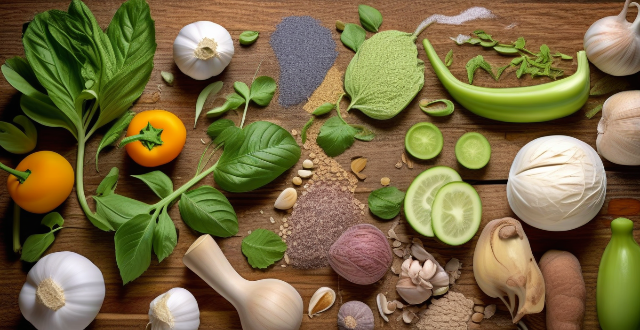
What ingredients are commonly used in Mexican cooking to create its unique flavor profile ?
The article provides an overview of the key ingredients used in Mexican cooking, including chili peppers like ancho, jalapeño, serrano, and habanero; herbs and spices such as cumin, coriander, oregano, and cilantro; and other ingredients like tomatoes, onions, garlic, lime juice, epazote, and hominy. It explains how these ingredients contribute to the distinctive flavor profile of Mexican cuisine and encourages readers to experiment with creating authentic Mexican meals at home.
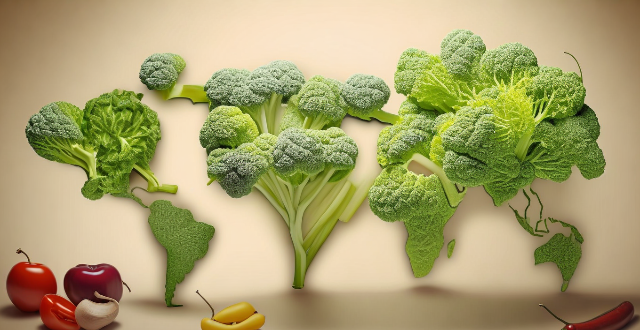
What role does cilantro play in Mexican cuisine in terms of flavor ?
Cilantro is a key herb in Mexican cuisine, adding flavor, aroma, and freshness to dishes. Its unique taste, described as citrusy, grassy, and slightly peppery, complements the bold and spicy flavors of Mexican cooking. Cilantro is used in salsas and guacamole, soups and stews, marinades and rubs, tacos and enchiladas. Its citrusy notes cut through rich ingredients, grassy undertones provide a refreshing contrast, and its peppery bite adds complexity. Cilantro is essential for enhancing the taste and aroma of Mexican dishes.

What are the key ingredients in Indian cooking ?
Indian cuisine is known for its rich flavors and diverse dishes. The key ingredients that make Indian cooking unique are spices, herbs, ghee, lentils, rice, yogurt, nuts and seeds, and bread. These ingredients add flavor, color, and aroma to the dishes and create authentic and delicious Indian cuisine.

What are some unique ingredients commonly used in French desserts ?
French desserts are renowned for their exquisite taste and delicate textures, which are largely due to the unique ingredients used in their preparation. These include vanilla beans, almond meal, cream, butter, lemon zest, and kirsch. Each ingredient plays a crucial role in enhancing the flavor, aroma, and texture of French desserts. Understanding the importance and usage of these ingredients can help you appreciate the artistry behind French pastry making and even try your hand at creating your own delectable treats.

How does the use of chilies contribute to the distinctive taste of Mexican food ?
Chilies play a pivotal role in Mexican cuisine, contributing heat, flavor complexity, color, and cultural significance. They offer varying intensities of spiciness, from mild to very hot, and their fruity or earthy flavors complement other ingredients. Visually appealing with vibrant colors, chilies also have nutritional benefits like antioxidants and metabolism boost. They are versatile in cooking, used fresh, dried, or smoked, and pair well with acidic and herbal ingredients. Chilies are integral to traditional dishes like enchiladas and mole sauce, showcasing their essential role in defining the unique taste profile of Mexican food.

How can I use bitters to enhance my cocktail recipes ?
Bitters are a crucial ingredient in many cocktails, adding depth and complexity to the flavors. Here's how you can use them to enhance your cocktail recipes: Understanding Bitters: Bitters are concentrated alcoholic extracts made from herbs, spices, fruits, and other botanicals. They are typically used in small amounts to add a subtle, aromatic flavor to cocktails. There are several types of bitters available, each with its own unique flavor profile. Using Bitters in Cocktails: Here are some tips for using bitters in your cocktail recipes: start small, experiment with flavor combinations, use as a garnish, and create your own bitters. Overall, using bitters is an easy way to elevate your cocktail game and create unique, complex flavors that will impress your guests.

How do professional bartenders measure ingredients for consistency ?
Professional bartenders use a variety of tools and techniques to measure ingredients consistently. Accuracy is crucial for maintaining the same flavor profile and balancing different tastes in cocktails. Efficiency is also important, as it speeds up drink-making and allows bartenders to focus on customer interaction. Jiggers are commonly used tools for measuring both large and small quantities of liquids. Measuring spoons are used for smaller amounts like bitters or syrup. Digital scales are used for precise measurements by weight, especially for ingredients like fruit juices or syrups. Pour spouts and containers help control the flow of liquids to reduce spillage and waste. Standardization processes such as recipe cards, batching, and taste testing are also essential. Recipe cards include detailed measurements for each ingredient, helping new bartenders learn quickly and maintain consistency. Batching involves pre-mixing a large volume of a single cocktail ingredient or an entire recipe, saving time during busy shifts and ensuring uniformity. Taste tests are crucial even with precise measurements, as bartenders adjust recipes based on customer feedback and ingredient freshness. In conclusion, professional bartenders rely on a combination of tools, techniques, and standardized processes to measure ingredients consistently. This ensures that they can replicate the perfect cocktail every time, providing a high-quality experience for their customers.

How can I make my favorite dishes vegetarian without sacrificing flavor ?
How to Make Your Favorite Dishes Vegetarian Without Sacrificing Flavor
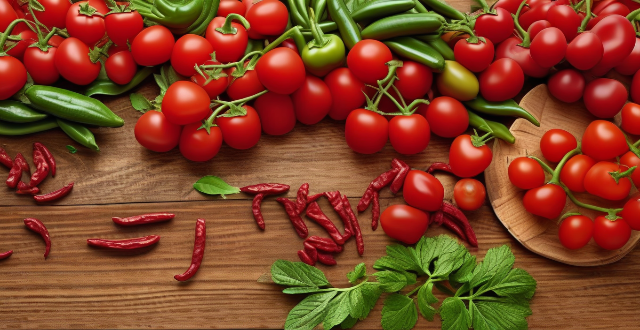
What are some traditional Mexican flavors ?
Mexican cuisine is known for its bold and vibrant flavors, which are a result of the country's rich history and diverse cultural influences. Some of the most traditional Mexican flavors include chili peppers, herbs and spices, fruits and vegetables, dairy products, and meats and seafood. These flavors come together to create the vibrant and delicious cuisine that Mexico is known for.

What are some gluten-free breakfast options that don't sacrifice flavor ?
Gluten-Free Breakfast Options that Don't Sacrifice Flavor: Gluten-free pancakes, oatmeal with fruits and nuts, egg dishes, smoothies, gluten-free cereals, and breads are all delicious and healthy breakfast options for those who are gluten-free.

How do I get that restaurant-quality flavor in my homemade crab cakes ?
How to Achieve Restaurant-Quality Flavor in Homemade Crab Cakes: - Freshness and quality of ingredients are crucial. - Lump crabmeat is preferred for its sweet flavor and good texture. - Use a combination of seasonings like Old Bay, mustard, Worcestershire sauce, and hot sauce. - Bind the mixture with mayonnaise or mustard lightly. - Pan-fry or oven-bake the crab cakes for different textures. - Serve with remoulade sauce and sides like green salad or roasted vegetables. - Allow the crab cakes to rest before cooking and avoid overcrowding the pan.

How do I properly season my stir-fry dishes ?
When it comes to stir-fry dishes, seasoning is key to achieving that perfect balance of flavors. Here are some tips on how to properly season your stir-fry dishes: 1. Choose the right ingredients: Select fresh vegetables and proteins that will complement each other in terms of flavor and texture. 2. Use a variety of sauces and spices: Experiment with different sauces and spices to find the perfect combination for your dish. 3. Balance sweet, sour, salty, and spicy flavors: A good stir-fry should have a balance of these four flavors. 4. Cook in batches and use high heat: Cook your ingredients in batches over high heat to ensure even cooking and maximum flavor. 5. Taste and adjust as needed: Taste your stir-fry as you go and adjust the seasoning as needed.

What are the key differences between classic and modern cocktail styles ?
Cocktail styles have evolved over time, with classic cocktails representing traditional recipes and techniques, while modern cocktails often showcase innovative ingredients and presentation methods. Classic cocktails are known for their simplicity, limited ingredient list, standard measurements, traditional garnishes, and historical significance. Examples include the Martini, Old Fashioned, and Daiquiri. Modern cocktails, on the other hand, feature innovation, complexity, craft methods, visual appeal, and locally sourced ingredients. Examples include the Earl Grey MarTEAni, Smoked Old Fashioned, and Lavender Lemon Drop. In summary, classic cocktails pay homage to the roots of mixology, while modern cocktails celebrate creativity and the ongoing evolution of the craft. Both styles offer a unique drinking experience and cater to different preferences among cocktail enthusiasts.
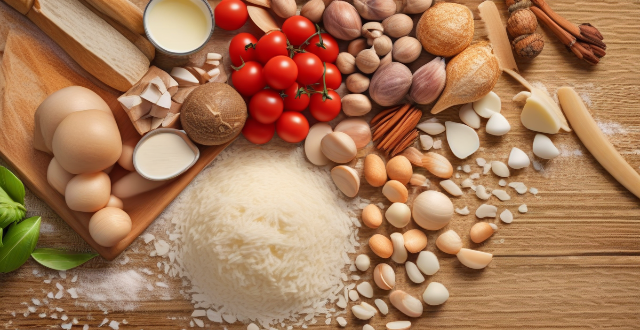
What kind of ingredients are commonly used in Japanese cuisine ?
Japanese cuisine is known for its unique flavors, fresh ingredients, and beautiful presentation. The most commonly used ingredients in Japanese cooking include white rice, brown rice, sweet rice, tuna, salmon, squid, shellfish, chicken, beef, pork, cabbage, eggplant, green onions, mushrooms, soy sauce, miso, udon noodles, soba noodles, ramen noodles, rice vinegar, sesame oil, nori, wasabi, and pickled ginger. These ingredients combine to create the diverse and delicious flavors that make Japanese cuisine so beloved around the world.

What kind of chocolate is typically used in French chocolate desserts ?
The article discusses the importance of chocolate selection in French chocolate desserts, highlighting the use of dark, milk, white, and unsweetened chocolate. It emphasizes the rich culinary heritage of France that demands quality ingredients, especially in chocolate desserts. The article also suggests considering the desired outcome of the dish, taste testing, and experimentation to find the perfect chocolate for a particular dessert.

How do I know if a product is truly organic ?
Identifying truly organic products requires looking for certification labels, checking the ingredient list, researching the manufacturer or brand, and visiting farmers markets and local stores. Certification labels such as USDA Organic, Euro-leaf, and JAS indicate that the product meets specific standards for organic production. The ingredient list should indicate that all ingredients are organic and free from GMOs. Researching the manufacturer or brand can provide information about their farming practices and quality control processes. Visiting farmers markets and local stores allows you to ask questions about the products and see them firsthand. By following these tips, you can ensure that you are getting genuine organic products that are free from harmful chemicals and pesticides.

How can I make my breakfast more colorful and visually appealing ?
How to Make Your Breakfast More Colorful and Visually Appealing: 1. Use fresh fruits and vegetables for color and nutrition. 2. Experiment with different grains and breads for texture and color. 3. Add spices and herbs for flavor and color. 4. Get creative with plating for visual appeal. 5. Incorporate edible flowers for beauty and flavor.

How can I make sure my paella has the right consistency and flavor ?
To ensure your paella has the right consistency and flavor, choose short-grain rice like Bomba or Calasparra, use fresh proteins and quality vegetables, cook with proper techniques including sofrito caramelization and correct liquid ratios, season well with salt and additional spices, let it rest before serving, and garnish with lemon wedges and parsley.

What makes the flavor of street tacos in Mexico different from those found elsewhere ?
The flavor of street tacos in Mexico differs from others due to authentic ingredients, traditional cooking methods, regional specialties, vibrant street food culture, and a variety of condiments.
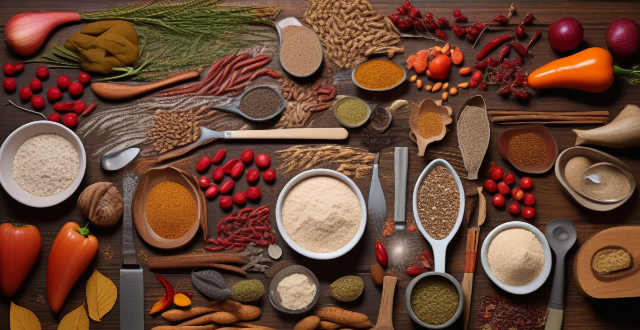
What is the significance of spices in Indian cooking ?
The significance of spices in Indian cooking is multifaceted, encompassing flavor enhancement, cultural traditions, and medicinal benefits. Key spices like turmeric, cumin, coriander, mustard seeds, fenugreek, red chili powder, garam masala, curry leaves, asafoetida, and tamarind contribute to the complex flavor profiles characteristic of Indian cuisine. These spices are used through techniques such as tempering, grinding, and roasting to create a balance of tastes and visual appeal. Historically, spices were valuable commodities in trade and are integral to traditional medicine and religious practices. Regional variations in spice use reflect India's diverse geography and cultural heritage. Understanding the nuances of spice usage allows for a deeper appreciation of the artistry behind Indian dishes.

How can I spice up my usual home-cooked meals with new flavors ?
To spice up your usual home-cooked meals, try using fresh herbs and spices, exploring global flavors, incorporating acids and sweetness, and adding textures and garnishes.

What are some tips for balancing sweet and sour flavors in cocktails ?
"Balancing Sweet and Sour Flavors in Cocktails: Tips and Tricks for Crafting Perfect Drinks"

What are some creative ways to use tofu in vegetarian cooking ?
Tofu is a versatile and nutritious ingredient that can be used in a variety of vegetarian dishes. Here are some creative ways to use tofu in your cooking: marinated and grilled tofu skewers, creamy tofu pasta sauce, tofu stir-fry, tofu bao buns, tofu scramble, and tofu dumplings. By incorporating these ideas into your vegetarian cooking, you can enjoy the many health benefits of tofu while exploring new flavors and textures in your meals.
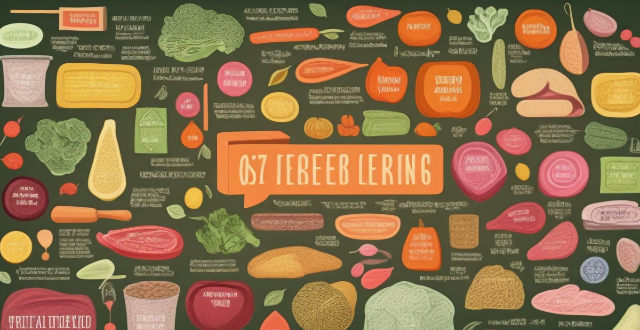
How does food labeling contribute to food safety ?
Food labeling is crucial for food safety as it provides consumers with essential information. It includes ingredient lists, nutritional information, expiration dates, manufacturing details, storage instructions, certification marks, allergy warnings, country of origin, precautionary statements, and environmental impact information. Proper labeling practices help identify ingredients, understand nutritional values, recognize potential risks, and make informed decisions about food consumption.

What's the best way to infuse alcohol with fruits or spices ?
Infusing alcohol with fruits or spices is a great way to add flavor and complexity to your drinks. Here are the steps to do it right: Materials Needed: - Alcohol of your choice (vodka, rum, gin, etc.) - Fresh or dried fruits/spices - Clean glass jar or bottle with a tight-fitting lid - Fine mesh strainer or cheesecloth - Funnel (optional) Steps to Infuse Alcohol: 1. Choose Your Ingredients: Pick high-quality fruits and spices that complement the flavor profile of your chosen alcohol. Popular combinations include vodka with citrus fruits or jalapeño, rum with tropical fruits or cinnamon, and gin with juniper berries or lavender. 2. Prepare Your Ingredients: Wash and chop fresh fruits into small pieces. For spices, use whole spices like cinnamon sticks or crush them slightly to release more flavor. Dried fruits can be used as they are. 3. Infusion Process: Fill your clean glass jar or bottle with the prepared fruits/spices, leaving about 1/4 of the container empty at the top. Pour in the alcohol until the fruits/spices are fully submerged. 4. Seal and Shake: Close the jar tightly and shake well. Store it in a cool, dark place, shaking it occasionally over the next few days to help release the flavors. 5. Taste Testing: After about 3-5 days, taste your infusion. If it's not strong enough, reseal and let it sit for a few more days. The longer it sits, the more intense the flavor will become. 6. Straining and Bottling: When you're satisfied with the flavor, strain the mixture through a fine mesh strainer or cheesecloth into a clean jar or bottle. Use a funnel to transfer it without spilling. 7. Enjoy! Your homemade infused alcohol is now ready to be enjoyed in various cocktails or served neat over ice. Remember, the quality of your ingredients matters greatly. Always use fresh fruits and high-quality alcohol for the best results. Cheers!

How does Chinese cuisine differ from other Asian cuisines ?
Chinese cuisine is one of the most diverse and influential cuisines in the world, with a history that spans thousands of years. While there are many similarities between Chinese cuisine and other Asian cuisines, there are also several key differences that set it apart. These differences include the use of ingredients, cooking techniques, flavor profiles, and regional variations within each cuisine. Chinese cuisine often uses a wider variety of ingredients than other Asian cuisines, including both meat and vegetables. Additionally, Chinese cuisine often incorporates more spices and herbs into its dishes than other Asian cuisines. Another difference is the cooking techniques used. Chinese cuisine often involves stir-frying or steaming foods, while other Asian cuisines may rely more heavily on grilling or baking. Chinese cuisine also tends to use woks for cooking, which allows for high heat and quick cooking times. In terms of flavor profiles, Chinese cuisine has a distinct flavor profile that sets it apart from other Asian cuisines. Chinese cuisine often features bold flavors such as garlic, ginger, soy sauce, and chili peppers. In contrast, Japanese cuisine may have a lighter, more delicate flavor profile that emphasizes umami (savory) flavors. Thai cuisine, on the other hand, may be spicier and more aromatic than Chinese cuisine. Finally, another difference between Chinese cuisine and other Asian cuisines is the regional variations within each cuisine. China has a vast geographic area with many different regions, each with its own unique culinary traditions. Similarly, Japanese cuisine can vary greatly depending on whether it comes from the northern or southern regions of Japan.

How can I tell if my shrimp is cooked properly ?
Cooking shrimp perfectly requires attention to color, texture, curvature, and flavor. Look for an opaque white color, firm but not hard texture, slight "C" shape curvature, and a clean, sweet flavor without fishiness. Use a thermometer, watch the timing closely, choose the right cooking method, and practice regularly to achieve culinary perfection with your shrimp dishes.

How long do homemade natural cleaners typically last before they lose their potency ?
Homemade natural cleaners' shelf life depends on factors like ingredients, storage, and concentration. To extend their lifespan, use high-quality ingredients, store properly, label with dates, avoid cross-contamination, and consider adding natural preservatives.

How can I make drinks look more appealing with garnishes ?
Garnishing drinks is an art form that can elevate the visual appeal of your beverages. It not only enhances the aesthetic but also adds flavor and aroma to your drink. In this guide, we will explore various techniques and ideas to make your drinks look more appealing with garnishes. Importance of Garnishes: Garnishes add visual appeal, enhance flavor and aroma, and create theme and ambiance. Garnish Ideas: Fruit garnishes like slices and wedges, herb garnishes like sprigs and leafy toppers, spice garnishes like cinnamon sticks and star anise, edible flowers such as pansy or viola, and miscellaneous garnishes like cocktail picks and salt rims. Techniques for Applying Garnishes: Rim treatments like wet rims and layered effects, floating garnishes like fruit slices and edible flowers, and skewered garnishes like combination skewers and visual balance. By incorporating various types of garnishes and employing different techniques, you can significantly enhance the visual appeal of your drinks. Remember to consider factors such as color, texture, and flavor when selecting garnishes to create a cohesive and attractive presentation. With these tips, you'll be able to elevate any beverage from ordinary to extraordinary in no time!